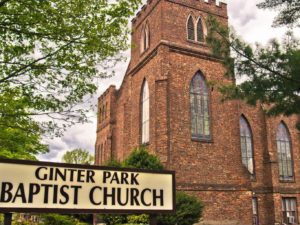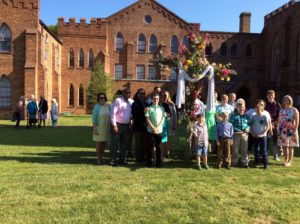This is our story.
It is a story we are making up as we go along.
It is less scripted than improvisational; less classical than jazz.
And it is not finished, because God is not finished with us.

Our building has served Ginter Park Baptist Church for most of its century-long history. We have two well-equipped worship spaces, large and small classrooms, a commercial-level kitchen, flexible event space, and so on. We have shared this space with individuals and with other church and community groups, and this sharing has enriched our relationship with our neighbors and contributed operating funds for the property. However, the growing maintenance costs of the building finally have outstripped our ability to keep up by means of a combination of congregational gifts and rental income.
The Problem
The process of coming to the decision we have made has involved looking backward, speculating on what the congregation might have done or might have avoided, how things might have evolved differently. If we had acknowledged the seriousness of the problem earlier, could we have taken steps to bring about renewed growth rather than continued decline? Could we, even at this point, seize on a bold new initiative that would revitalize us as a congregation and allow us to continue in this place? Many of us believed so, at first, and there was great resistance to “giving up.” Some of us resented our pastor’s efforts to help us acknowledge the problem, while she herself struggled with the loss of her expectations for the congregation she had come to serve. As a congregation we considered, and reconsidered, various options.
Gradually and through much personal pain, most of us came to see that there was no feasible option that would keep us in our buildings. And as we let go of that regret, we discovered perspectives that surprised even ourselves. We came to understand that this space which we love is now keeping us from doing and being what we are called to do and to be. We have increasingly had to choose between being church and being caretakers of our building. This building no longer serves the purposes we need our physical space to serve. This realization has been sad for all of us who have loved, and still love, this building; but on the other side is possibility. Far from abandoning us in despair, the prospect of leaving our building created in our congregation a new sort of energy, a desire for one another’s fellowship that transcends the desire to be in a particular building. Gradually, we began to imagine a future without the crippling financial constraints of building maintenance—and that future began to look promising.
The Process
The first, excruciatingly difficult, step was to acknowledge that we had a serious problem. Like every journey of recovery, ours had to begin with the admission that our present condition was unsustainable.
Our Baptist identity means both that our building is entirely the responsibility of its occupying congregation and that there was no denominational official assigned to help us work through this challenge. We engaged the services of a consultant from the United Church of Christ to do the hard work of presenting us with a clinical diagnosis of our situation. Because he was an “outsider,” we were free to resent him as an outsider, to think that his facts and figures didn’t apply to our situation, to be glad to see him gone. But he confronted us with a reality we had been ignoring: we had choices to make. One choice would be to do nothing, to kick the problem down the road and deal with it later—but we would have done so in the knowledge that we had chosen to do nothing. Another choice was to disband, liquidate our resources, and go on our separate ways. The third choice was to move from our present location but to continue as church.
Our next step was a series of congregational meetings in which we discussed the options, imagined scenarios, and wished that the situation were not as it was. These meetings were listening sessions in which no binding decisions would be made. Very gradually, the majority of the congregation came to see that our path ahead lay through the sale of the building.
The motion to place our property on the market was printed and distributed to the congregation. We called a church business meeting for the ballot vote and conducted it on a Sunday after worship. This was a painful moment. The two-thirds margin in favor of the motion was reached, but barely. We were still by no means unified as a congregation, although we had made a decision, and many of those who voted to sell were still unsure what lay ahead.
After the decision to list the property for sale, two special committees were elected. One was the Future Ministry Team, commissioned with charting our next steps and recommending to the church where we should plan to worship once the building sold. The other was the Transition Team, which began immediately to take inventory and plan the logistics of relocation.
The Future Ministry Team soon realized that decisions about a permanent new space required the deliberation of the whole congregation, so they explored various possibilities for the church’s temporary location. Retail space was one option, but it would be costly to make a storefront property into a welcoming worship and educational space. The team also discussed with other congregations the possibility of renting classrooms and worship space or a space that could be converted to worship space, finding pros and cons with all the available options.
Meanwhile, the congregation received a bid to purchase the church property, which increased the urgency with which the two teams proceeded. In a called business meeting on a Sunday in March, the congregation voted to accept the offer and move forward with the sale of the building. The very next Wednesday night, the Future Ministry Team presented their proposal of Baptist Theological Seminary at Richmond as Ginter Park Baptist Church’s temporary location. The seminary and GPBC have historically had a working relationship, with many of the seminary’s opening convocations held in Ginter Park’s sanctuary. The seminary offers classroom space and a chapel adequate to the congregation’s needs, and the space is not used by the seminary on Sundays. Moreover, BTSR offered the space at a very reasonable rental rate. The congregation will be able to preserve proceeds from the sale of the property to apply toward securing a future, permanent location.
 The Promise
The Promise
So what happens next? In many ways, we admit that we don’t know. We are committed to one another in this specific expression of the body of Christ. We are called to serve our neighbors. What shape that will take is still unclear. We now know, however, that we are capable of facing our most arduous challenges; we are able to embrace change even when it means letting go of what is dear to us; and we do not have the luxury of waiting until our plans are complete, but that we must instead live into our own future.
We are still experiencing a range of emotions: sadness, loss, and uncertainty, but also calm, relief, and unity of purpose. Indeed, many of us have realized, somewhere along the way, that as a community we have begun not only to recover our bearings but to move on a path that feels a great deal like rebirth. We have started telling a different story about ourselves, claiming that we are part of something new. It is a narrative not about decline but about resurgence. In this Easter season, we have come to understand Christ’s resurrection differently by experiencing our own. This Pentecost is not about the church’s ending but about its beginning.
Conclusion
We realize that we do not have all the answers. This is our story, unique to our community and our situation. The struggles we have weathered may not be those faced by another congregation. But we have chosen to share our experience, to let others see inside our walls, in the hope that our account may be instructive. Part of the loneliness of giving up a church building is wondering why we must go down this path while other churches seem to be thriving; but as we entered into conversations with other churches about sharing space, we learned that other churches are struggling too. Deferred maintenance and declining numbers are leading toward unsustainability, denial, and hard choices. We pray that our experience can encourage other congregations to look for the movement of the Spirit in painful circumstances, as God continues to transform us into a future of new possibility.